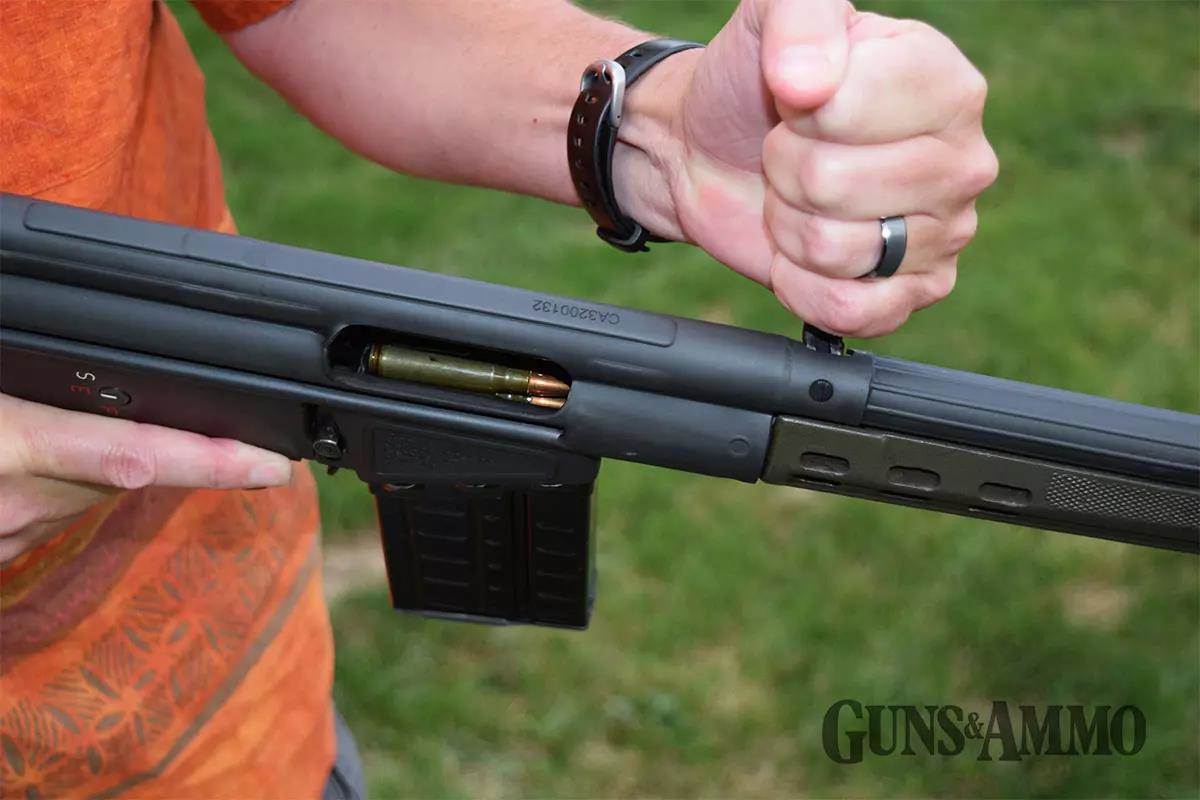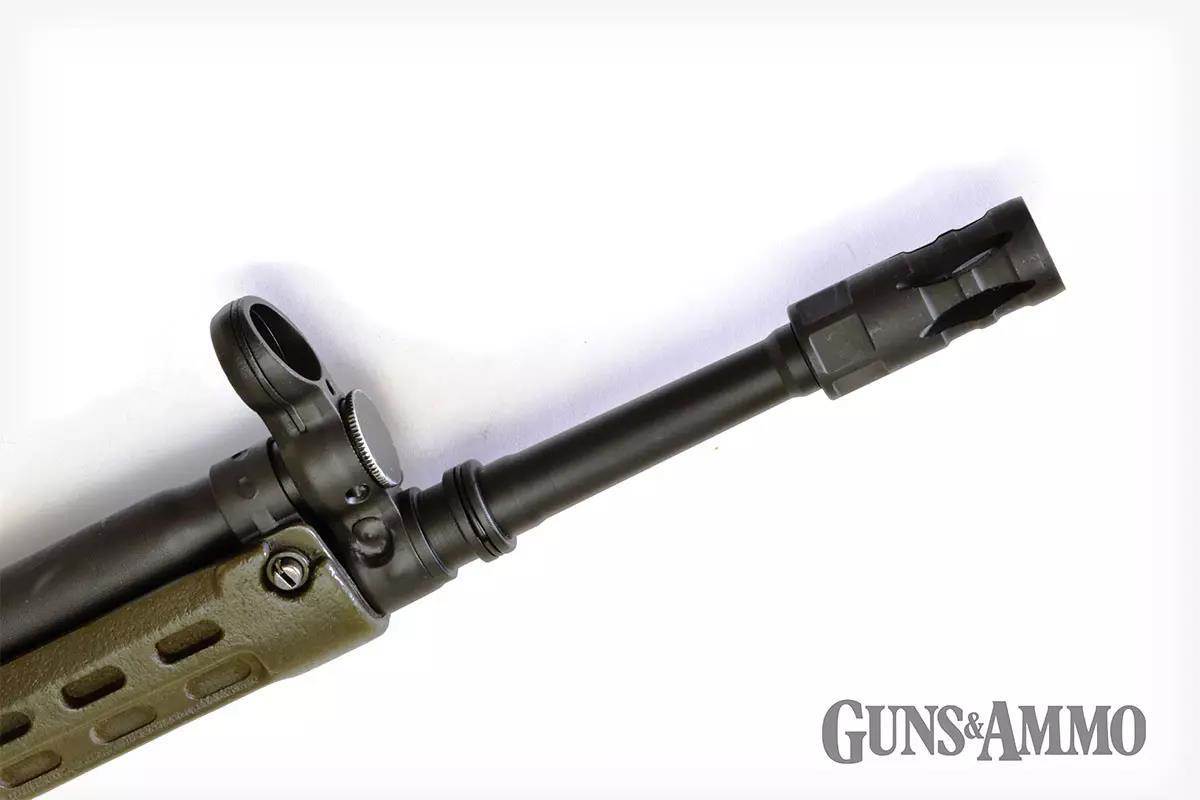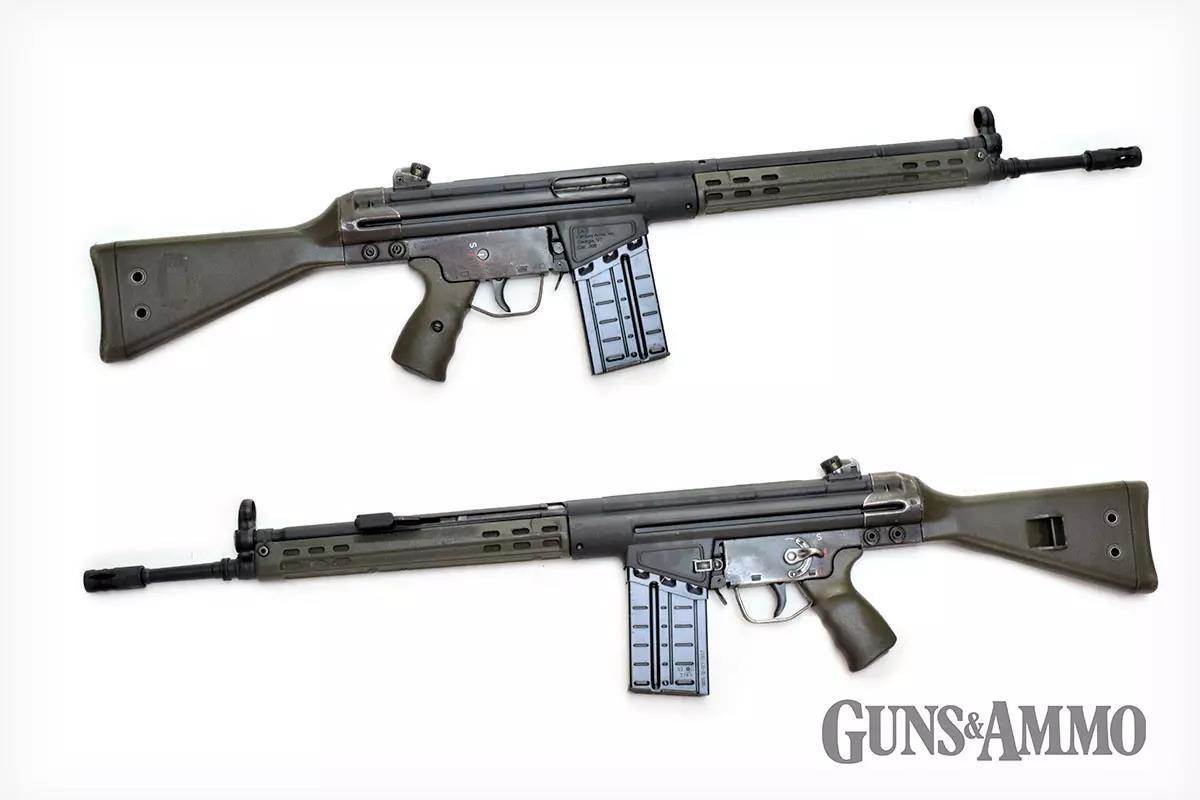Century Arms’ CA-3 is one of those new/old guns you occasionally see on the market. It is a somewhat new offering from them…but it’s an old design. It is made with new parts from PTR…as well as surplus parts. But what’s old is new again…or something like that.
Anyone with a passing familiarity with military firearms will recognize the CA-3 as being a Heckler & Koch G3-pattern rifle, but I know that there are new gun owners every day who entering the gun world, and they may have never heard of the G3, so let me lay down a little history before we dive into the specs of the gun.
The silhouette of this rifle is very distinctive, as is the original HK G3. Chambered in 7.62 x 51mm (.308 Winchester), the G3 is a select-fire rifle usually fed from 20-round box magazines. If you ever hear anybody throw out the term “big-bore battle rifle”, if they’re not talking about the FN-FAL, they’re talking about the G3. The story of the development of this rifle is quite detailed and could be the subject of a separate article, but simply put it was the result of a combined effort between Mauser, CETME in Spain, and H&K.
While designed in the 1950s it was used by militaries around the world for at least fifty years, and you still might see it in the hands of troops in Africa and Mexico. It has been used in numerous wars and brush-fire conflicts and proven itself time and time again. Over 7 million were produced, and it has a reputation for reliability and durability. The semi-auto version of the design, the HK-91, was imported into the U.S. for years, but the 1994 Assault Weapons Ban put a stop to that.
Advertisement
Century Arms earned their reputation for importing surplus firearms, but have moved away from that in the past decade or so, making their own guns. The CA-3 is a bit of a return to their roots, as the CA-3 combines new American-made parts by PTR (trunion, barrel, flash hider, stamped receiver, hammer, sear, and charging handle) with surplus parts sourced overseas (stock, forend, sights, trigger group, bolt, and bolt carrier).
The rifle features an 18-inch barrel made of chromoly 4150 steel. Instead of the traditional metric thread pattern you’ll find the muzzle threaded 5/8×24 and tipped with a birdcage flash hider that is very similar to the original HK flash hider. Overall, this rifle is 40 ¼ inches long and weighs 9 lbs. 5 ounces empty with no magazine, although it is supplied with one 20-round magazine. As for spares, you can find surplus aluminum and steel 20-round magazines in lots of places online for very reasonable prices, although they aren’t nearly as dirt cheap as they used to be when this gun was still in use all around the world. You may even be able to find new-in-wrap magazines, although you’ll pay more, and probably won’t need them—the HK G3/91 magazine is the perfect example of German overengineering, where even the aluminum magazines are so strong I think you could drive a car over them without making a dent.

The CA-3 operates via a roller-delayed blowback action. The rollers in the bolt are quite large and lock into recesses in the barrel extension. The bolt assembly consists of a large bolt and an even larger bolt carrier assembly. This roller-delayed blowback action was sized down first for the HK53 (5.56 NATO) then for the MP5 (9mm). The MP5 in 9mm is one of the softest recoiling submachine guns ever made, but that same roller action paired with rifle calibers provides more recoil. The polite way to describe a G3’s recoil is “robust”. You’ll definitely know when you pull the trigger.
Advertisement
The bolt is cycled by a folding handle at the front left of the gun, about halfway down the handguard. It does not reciprocate when shooting. You can lock it back using a notch at the rear of its travel, and when you’re ready to send the bolt home it’s time for the legendary, iconic HK slap. Slap the bolt handle down with the palm of your hand, and the bolt will slam home with a satisfying sound and feel that studies have shown increases testosterone.

The bolt will not lock back on an empty magazine, which is the main complaint with HK-pattern roller locks. You’ve got your choice when it comes to magazine releases—the paddle at the rear of the magazine well, which almost everybody uses and which works as well for left-handers as right, and the button on the right side, which is out of reach of your trigger finger if you’ve got a firing grip on the gun. Most people forget that button is even there.
The surplus parts on the CA-3 are easy to spot due to wear—the finish is worn thin. Considering how much people are paying for custom “battle-worn” Cerakote finishes, it comes standard on the CA-3…. If you want a gun that’s factory fresh, this one isn’t for you. If, on the other hand, you are looking for a vintage design with a little character, you should check it out. All the furniture on this gun (forend, pistol grip, stock) is green polymer. They also have seen some use and show wear. There are narrow handguards and wide handguards for the HK G3, and the handguard on the CA-3 is the narrow design—and to be honest, I can’t decide if I like the narrow or wide handguards better, in looks or feel.

The handguard pops off when you remove one pin. The buttstock comes off if you pop out two pins, and the pistol grip is held in place by one flat-head screw. If you don’t like the narrow handguard and want a wide one, or don’t like the green and decide you want an all-black gun, you’re in luck—the surplus market is full of them. A bit of research showed me used black handguards start at $17.95, and pistol grips are less than that. As the stocks have a stamped metal component, they are more expensive, but you can buy just the center stock section, and swap out all that green for black for less than $100 if you’re smart about it. I suggest checking out the HK Parts website to start. However, there’s a reason so much of the surplus G3 furniture is green—these guns were shipped around the world, and saw use in jungle-y areas. If you want that authentic look, this is as authentic as those all-black guns.

The trigger group housing (it’s technically not a lower receiver) in the CA-3 is steel, and one of the surplus parts. My sample had definite wear, especially to the selector lever…but that well-used selector lever was buttery smooth to work. The selector has S-E-F markings (same, semi, auto), but unfortunately the full-auto F setting doesn’t work.
Other than the bolt not locking back on empty magazines, the most common complaint with HK roller locks is the hard-to-reach selector. Unless you have giant paws, you’ll have to take the rifle off your shoulder and maybe twist it a bit to reach the selector with your thumb.
The front sight is a post inside a protective ring, and an iconic HK design. The rear sight is a rotating drum. There is a stepped notch marked 1, and small apertures marked 2, 3, and 4 for shooting at distance. The apertures are the same diameter, just different heights. It’s adjustable for windage via a Philips-head screw. To adjust the rear sight for elevation, to save yourself a lot of grief and swearing or grinding down the tips of your favorite needle-nose pliers, buy a rear sight tool. HKParts sells theirs for $29.95, and makes the process of zeroing your rifle quick and easy—although you’ll need to watch a video to see how it’s done, as of course (German engineering) it’s a bit counterintuitive.

The rifle comes standard with built-in sling mounts, a steel circle for a snap hook (or 550 cord) below the front sight, and a slot in the buttstock.
HK roller-locks are known for a lot of things, but light trigger pulls are not one of them. The trigger pull on my sample CA-3 was better than I was expecting. The single stage pull was still a bit long, but it was smooth and not as heavy as many I’ve shot. Total pull weight was 8.5-lbs. These are not match guns, these are battle rifles, with trigger pulls meant to survive untrained recruits.
The HK G3 was a very modern, modular design for its time. The serialized part is the stamped upper receiver, and you’ll find the serial number on the top of the receiver. If you pop out the two pins holding the stock on, the lower receiver pulls off the bottom, and you can remove the bolt/carrier for cleaning—simple and easy. The technique for removing the bolt from the carrier is easy, once you know how/where/when to push and twist—I suggest doing a quick YouTube search. As all the HK-pattern bolts and carriers work the same, so videos showing you how to disassemble an MP5 bolt carrier for cleaning work just fine for the CA-3.

There are clamp-style scope mounts which fit to the two small bulges on the receiver between the rear sight and the ejection port if you want to attach an optic. Most modern mounts feature a length of rail, and low-mounting a red dot there will put the dot above the protective ring of the front sight.
The CA-3 is a piece of history, and I mean that in every way—you get an interesting combination of new and vintage parts in a .308 battle rifle that’s as combat-proven as any design on the market, at a price far below that of a new-new gun.
Century Arms CA-3
- Type: Roller-delayed Blowback
- Caliber: 7.62×51 NATO/.308 Win
- Capacity: 20
- Barrel: 18 in. Chromoly 4150 Steel; 1:10 twist
- Length: 40.5 inches
- Length of Pull:
- Muzzle Device: Birdcage Style Flash Hider
- Weight: 9.5 lbs.
- Trigger: 8.5 lbs. (tested)
- Sight: Rotating Drum rear, adj.; Fixed front post
- Safety: Selector Switch
- MSRP: $999
- Manufacturer: PTR, milsup
- Importer: Century Arms, centuryarms.com
Read the full article here


19 Comments
Anyone know how the CA-3 compares to the PTR-91, which is also G3-based but newer?
If it’s anything like the original G3, this will be a tank. But are the internals up to modern standards?
Reliable semi-auto .308 rifles at this price point are rare. The CA-3 might stand out.
The G3 has a legendary reputation. Curious how Century Arms balances that legacy with surplus parts.
The original G3 was expensive new. Century Arms is making it more accessible. Will it be a crowd-pleaser?
For new shooters, this might be a good intro to big-bore rifles. The .308 platform is hard to beat.
The PT870 looks great. Hope they improved the trigger pull compared to the original.
For collectors, this might be a must-have. For shooters, depends on the fit and finish.
Hope they included modern safeties. The old G3’s ambidextrous version was finicky.
Surplus parts in a new rifle? That could be a deal-breaker for some, especially if reliability is questionable.
The CA-3 looks like a great option for those who want a battle rifle without the Select Fire price tag.
7.62×51 firearms are making a comeback. This could be a solid choice for home defense or hunting.
The G3 influenced so many firearms. Good to see its legacy continued.
Will this be chambered in .308 or stick with 7.62×51? Same round, but marketing matters.
Interesting to see modern companies reviving classic designs like the G3. Have they improved anything for today’s market?
Century Arms has a history of mixing new and old. Hope they kept the G3’s durability in this model.
This could be a sleeper hit if it delivers on performance. The G3’s pedigree is undeniable.
The G3’s ergonomics are iconic. Wonder if Century kept the original feel.
Not sure how I feel about mixing old and new parts. Quality control could be an issue.